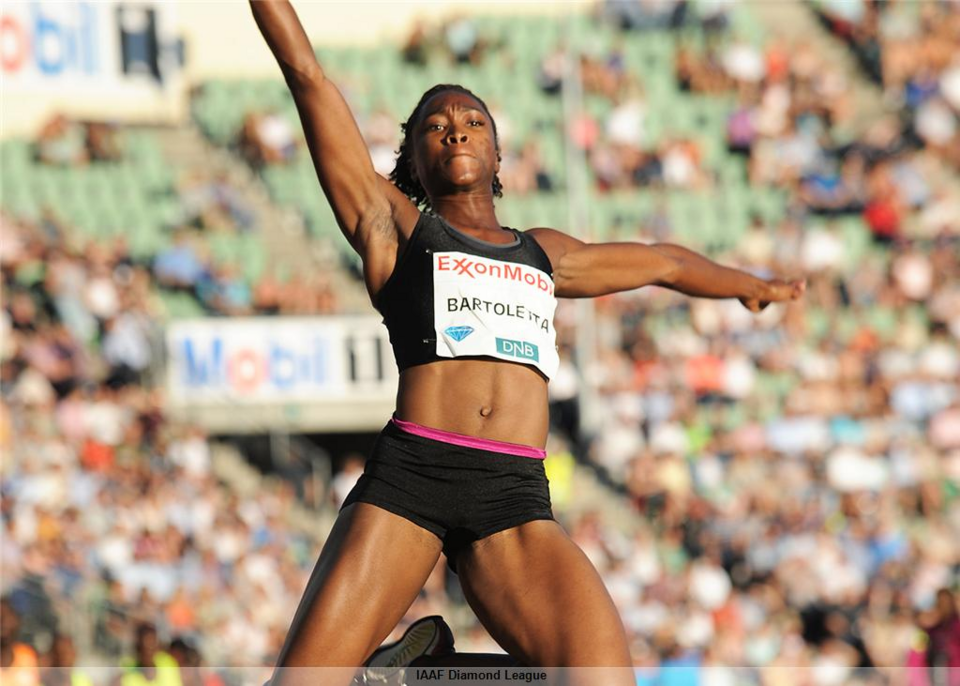The US athlete has concentrated on sprinting in recent years following a serious knee injury suffered in 2006 produced an effort of 6.98m with her final jump, just four centimetres down on the mark of 7.02m with which she leads this year’s world lists.
“The windy conditions made it a challenge but it was a challenge all of us had so that made it an equaliser,” said Bartoletta. “We were all jumping up and down in our tracksuits to stay warm but I kept my focus and I just never gave up so I’m very happy with that approach.”
Bartoletta has already got word that she has been selected for the IAAF Continental Cup in Marrakech, Morocco, next month and it looks like that she will have another duel with France’s two-time European champion Eloyse Lesueur, who she edged out of top spot with her last jump in the Swedish capital.
Last week, on the eve of the meeting in the picturesque 1912 Olympic Stadium, Bartoletta recalled how her doubts about being able to harness her improved speed to a long jump runway after so many years away were dispelled by the memory of the risks she had taken in 2012, when she had put her whole athletics career on ice.
In October of that year, two months after earning a gold medal at the London 2012 Olympic Games as part of the US 4x100m relay team, Bartoletta (nee Madison) joined fellow US athletes Lolo Jones and Hyleas Fountain in training for the US women’s bobsled team.
Bartoletta made the team, along with Jones. She and her team mate Elana Meyers finished third in her first career World Cup competition on November 9, 2012.
She returned to the track the following season but, as she explained, the process was not without complications.
“For me, 2013 was a rougher transition, because my previous coach Rana Reider took a job with UK Athletics and I was kind of rushed for time to get a new coach.”
Consequently, she began working with Loren Seagrave, and now has Russian long jumper Darya Klishina as a training partner in the USA.
In March of this year, competing in Sopot, she added a second IAAF World Indoor Championships 60m bronze medal to the one she earned in 2012 but the desire remained within her to return to the event at which she had made her international breakthrough by winning gold at the 2005 IAAF World Championships in Helsinki.
A World Indoor title followed in March 2006 before she tore the cartilage and broke the patella in her right knee and, following her recovery, she concentrated on her sprinting; but her diversion into winter sports, throwing herself into the back of a rapidly accelerating bobsled while running at top speed, convinced her to risk a return to the runway with all her new speed and power.
“That was way more frightening!” she said. “But I am really grateful to my team for bearing with me when I said, ‘Know what? I think I can jump again!’
“I have learned that this career belongs to the athlete. You don’t just walk into a new coaching situation and do whatever is told to you. I have started to approach my career differently. Me, my coach, my manager, my husband, we have mastermind sessions, with input from all.
“The programme I train on is the culmination of all these great minds. I have lots more trust and faith in everything I do on the track. It would be easy to be like ‘Should I be doing this? It’s been seven years.’ But out there on the runway I have no shadow of a doubt.
“As for me, I’m competitive about everything – you know, ‘who can load the dishwasher fastest?’ I don’t think the long jump outweighs the sprints. The long jump is more fun, the 100 is more intense, but I tend to bring a different personality to each event.”
Mike Rowbottom for the IAAF and the IAAF Diamond League
23 August, 2014






